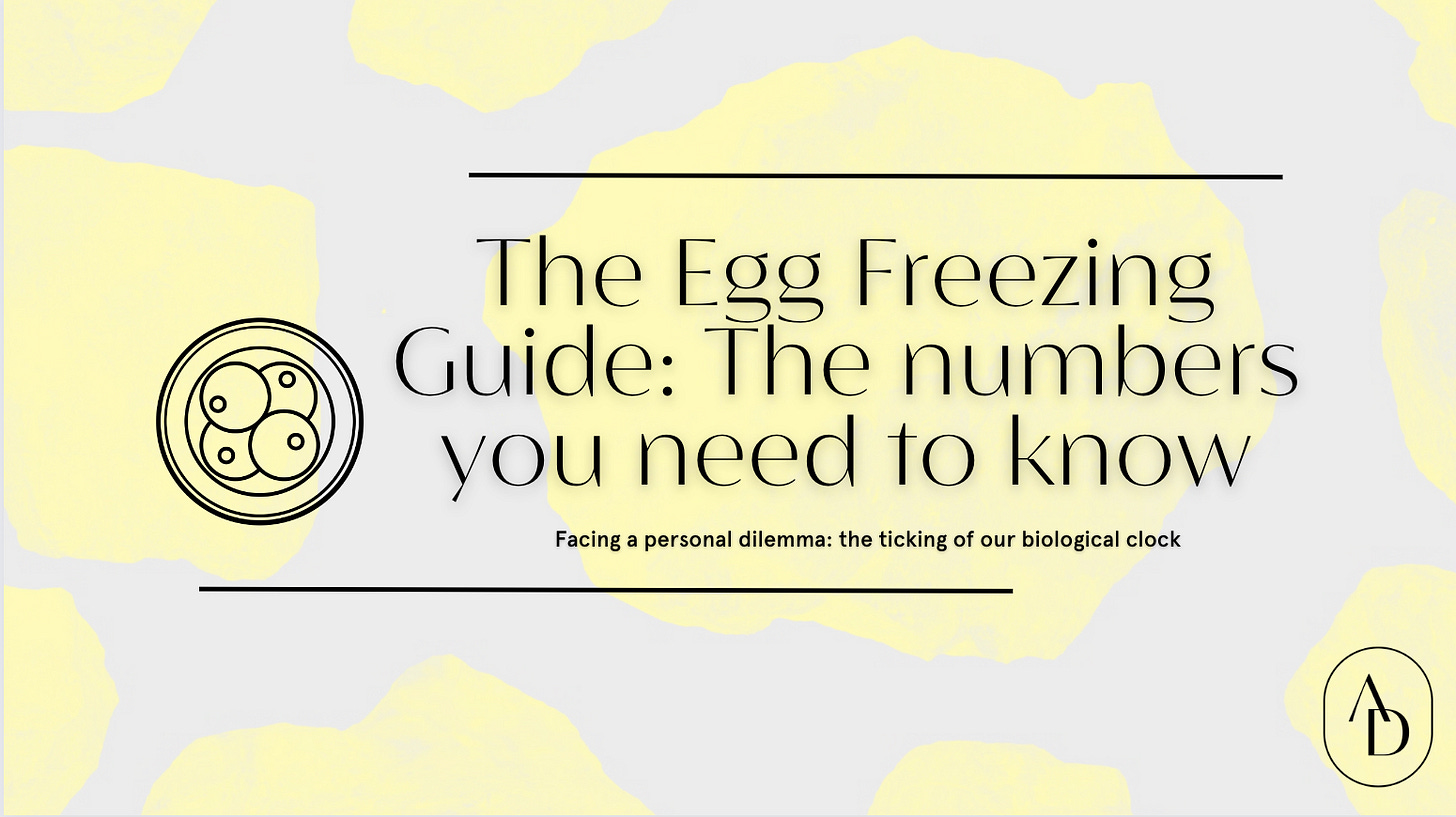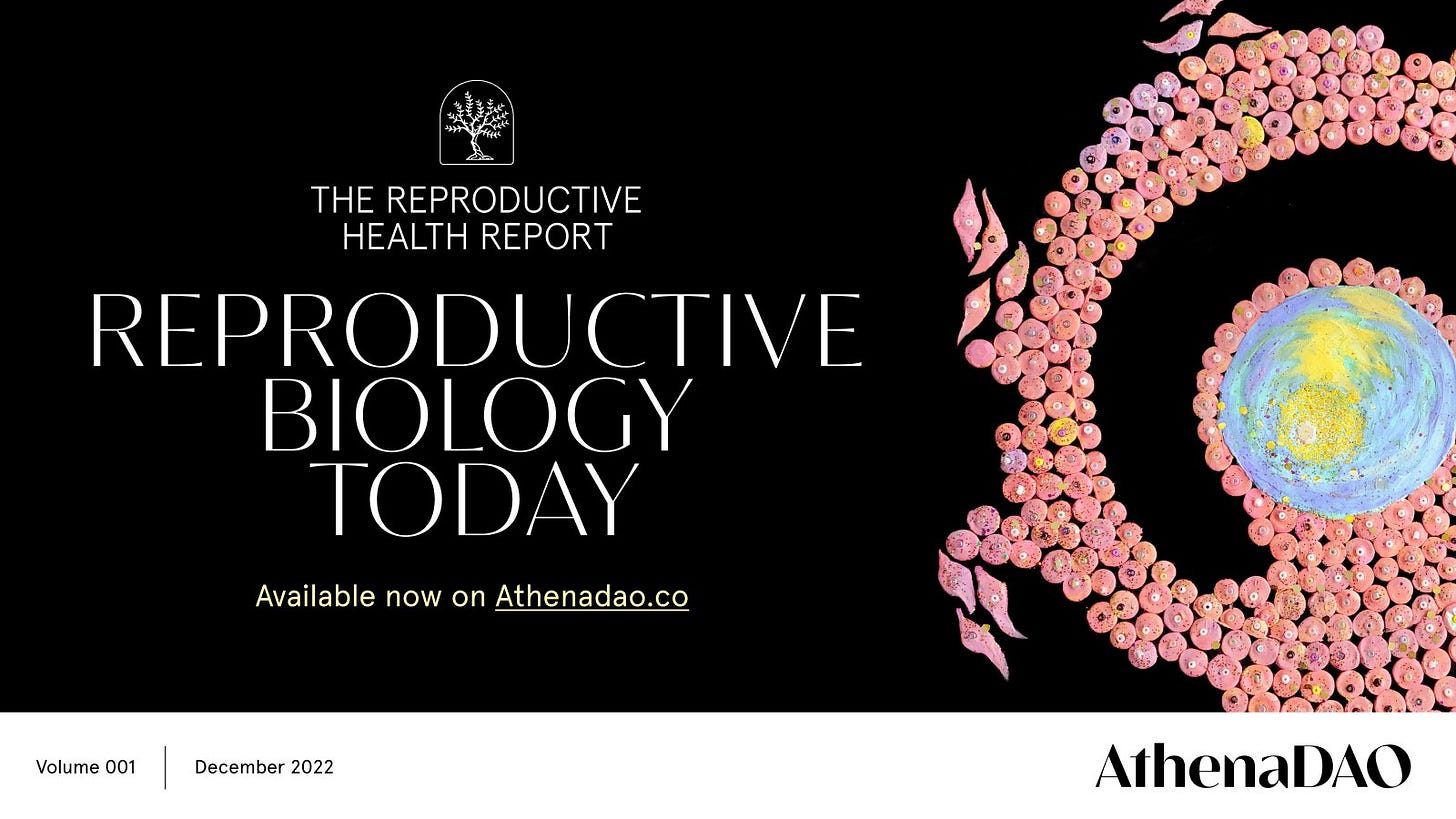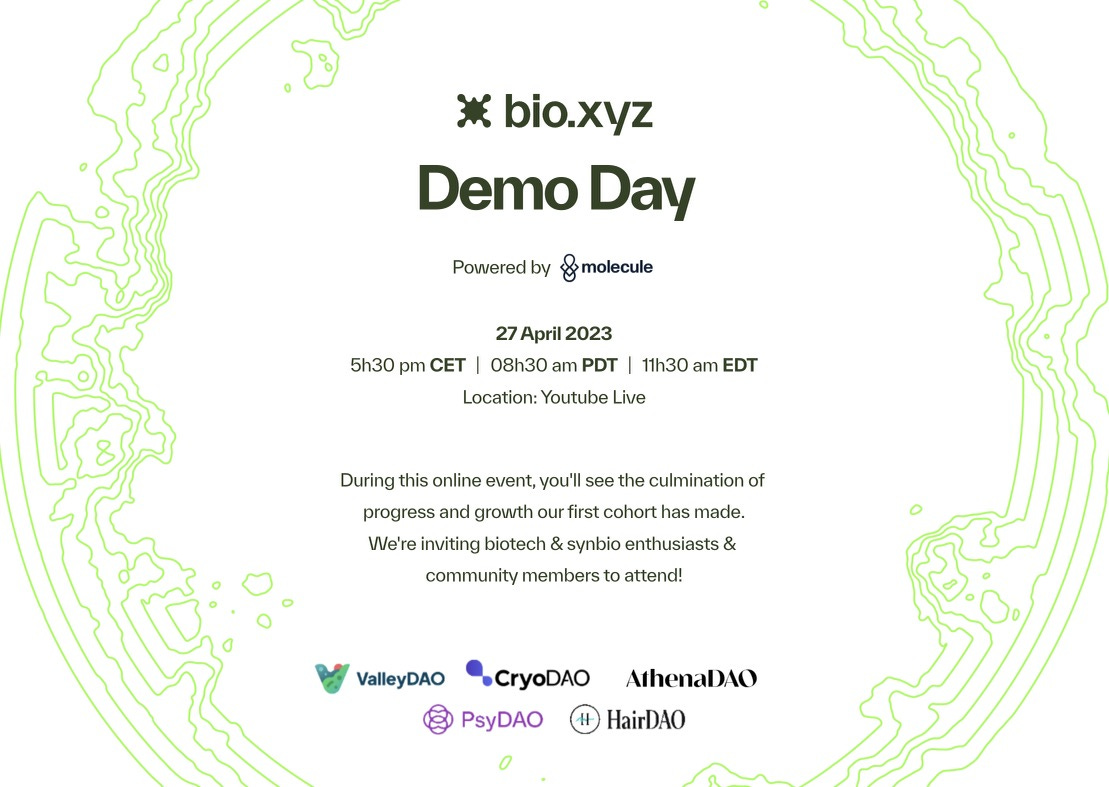The egg freezing guide
Part 1 - The numbers you need to know.
Hello 👋 and welcome to AthenaDAO’s Newsletter where we explore women’s health at the intersection of research, tech, and web3.🪩
At a recent Web3 event, a friend asked for advice on egg freezing. It made me realize that we needed to start making some of the valuable information we learn from researchers and clinicians more widely available. This was the inspiration for this first guide into egg freezing. As we are already working on the second volume of our Reproductive Health Report, we also want to make sure we can become a trusted source of information as well as be able to point all your reproductive health questions to the correct resources. Our discord community is always open and you can always email community@athenada.co if there is a subject you want us to broach or something you are currently looking for.
More importantly, join our movement, if you are motivated by the mission to get women’s health research the attention it deserves. Laura Minquini
By Nidhi Parekh, founder of The Shared Microscope
Data and medical information were checked by Dr. Maria Marinova & our lead OB-GYN Dr. Melissa Walsh
Meet Alex, a 27-year-old professional working in the exciting world of tech and Web3. As she navigates the challenges of her career, she is facing a dilemma that women her age face: a ticking biological clock.
Determined to take control of her reproductive future, Alex has decided to freeze her eggs. However, she has found the resources online to be confusing and overwhelming. She wishes the process was simpler.
This decision was driven in part by recent bloodwork. The results helped her realize that her ovaries were aging despite her feeling like she was still 21!
Alex is excited to take charge of her fertility and explore the possibilities that modern technology can offer. She hopes that by sharing her experiences, she can help others navigate this process more easily and with greater confidence.
This story strikes a chord with many of us.
We’ve designed this general egg-freezing guide to help you make informed decisions if you are considering it or curious about this process.
This guide will be split into three different parts - one concerning the numbers behind egg freezing, the second one concerning the process and feasibility (Ex. costs), and the third one on a global round-up; did you know some countries offer it as part of healthcare? In this first part, we’ll be tackling the numbers.
The Basics
Let’s start with some numbers you need to know and the most common questions.
What is egg freezing? How is it different from embryo freezing?
We’ve been hearing a lot about our biological clocks moving forward. As we age, our chances of conceiving dwindle quickly. With this, the quality of our eggs also drops.
Egg freezing is a way for women to save their eggs for when they want to have children later in life. In other words, it allows individuals to delay childbirth. Sometimes, like if you’ve been diagnosed with cancer, your doctor may recommend looking into egg-freezing options. Briefly, the eggs are taken out (by a process called egg retrieval) and frozen, so they can be used later when the person is ready to have a baby.
Unlike egg freezing, embryo freezing involves taking a person’s eggs and fertilizing them with sperm in a lab to create embryos. These embryos can also be frozen and used later during fertility treatments.
The main difference between egg freezing and embryo freezing is that egg freezing happens before fertilization, while embryo freezing happens after fertilization. Additionally, egg freezing is usually done for fertility preservation, while embryo freezing is typically used as part of fertility treatments.
How much more successful is egg freezing if you do it in your 20s vs 30s?
The success rates of egg freezing depend on several factors, including the age of the person from which the eggs have been retrieved. Freezing your eggs at a younger age increases the likelihood of a successful pregnancy in the future.
Freezing your eggs at a younger age increases the likelihood of a successful pregnancy in the future.
According to one study that looked at a total of 543 patients who underwent 800 oocyte cryopreservation, the median age of a person freezing their eggs was 38.3 years. The overall chance of live birth from the frozen eggs was 39%. For women who were younger than 38 when they froze their eggs, the live birth rate was 51%. This increases to 70% if 20 or more eggs were frozen. (If you want to look at more data, Dr. Walsh also recommended this paper)
In an interview with the New York Times, Dr. Marcelle Cedars, professor and director of the division of reproductive endocrinology at the University of California San Francisco, provides a sobering reminder. “There’s not a baby in the freezer. There’s a chance to get pregnant.” In other words, there is no guarantee that you will get pregnant when using your eggs, but the sooner you freeze them, the better your chances of becoming pregnant.
People who waited too long to freeze their eggs and tried later to become pregnant had a lower success rate of pregnancy. If you’re thinking of freezing your eggs, NOW is a good time. Start what you can today - find some clinics, then choose one, and start the retrieval and freezing process. The general advice we’re hearing from doctors, patients, and anyone else is: “The sooner the better.”
How successful is egg freezing? What are the success rates of using a frozen egg to get pregnant?
The success rates of pregnancies with frozen eggs can be - and we can’t lie about it - abysmal. According to data provided by the UK government body - The Human Fertilization and Embryology Authority (HFEA) - only 22 of 1,204 thawed eggs ended in pregnancy.
Dr. Zhongwei Huang’s experience, an IVF specialist, and the Deputy Director of the Asia Centre for Reproductive Biology & Equality stated in our Reproductive Health Report: “In IVF, usually, 15 mature eggs would be good, but ‘quality can be another issue.’ From here, other concerns are considered during the actual fertilization step such as: Can the sperm really fertilize the eggs? Can the fertilized eggs develop into embryos? ‘These are the things that we have little control over and sadly the attrition rate can go even higher at this step.’”
Here’s more on these statistics, as written in an article by the BBC:
“1,204 eggs were thawed - but we don't know how many women or rounds of IVF that represents. Of these, 590 eggs (49%) were fertilized. Of the 590 eggs fertilized, 179 (30%) were transferred back to a patient. Out of the embryos transferred, 22 resulted in a pregnancy (13%). That year, 6,199 were frozen but these are unlikely to be the same eggs being thawed.
There is more recent data on embryo transfers, but the HFEA does not routinely publish the above data on thawing and fertilization.”
The article then goes on to report:
“Women who were under 35 at the time their eggs were frozen have the highest number of births per treatment cycle, according to HFEA data, and this rate declines with age. So, a younger, healthier woman could have a higher chance than 19%...
... The HFEA also points out that very small numbers of women in the UK who freeze their eggs actually go back to use them, so it's difficult to draw too firm a conclusion from such a small sample.”
Just why is this number so low? At every stage of the egg freezing, fertilization, and implantation journey, eggs are lost. In other words, when you freeze your eggs, you may lose the viability of some of the eggs in the freezing process, some of them in the thawing process, and some may not fertilize with the sperm and may be lost.
At every stage of the egg freezing, fertilization, and implantation journey, eggs are lost.
The fertilized eggs (now embryos), will then be implanted into the womb and we know that not all of these will “stick.” To make matters worse, we know that not all pregnancies translate to live births, adding another crappy layer to a process that is already pretty shoddy.
Contrarily, another study portrays a really positive result:
“The age at the time of freezing and the number of stored oocytes are the key factors that determine outcomes. It is estimated that on average, 20 oocytes are required to achieve a pregnancy with the minimum proposed number being eight to ten. However, for a given age, success rates will reach a plateau which cannot be surpassed regardless of oocyte number...
The cumulative probability of live birth rate in the most optimistic scenario was reported as high as 94.4%, but this was limited for women who electively froze their eggs at 35 years of age or younger with 24 oocytes in storage. For 10 oocytes in storage, the cumulative live birth rate in this age group was 42.8%. For women who cryopreserved oocytes at an older age, the success rate was markedly lower reaching 5.9% for 5 oocytes and 17.3% for 8 oocytes.”
It’s not all bad news - especially if you’re still in your 20s and early 30s. You can improve your chance of pregnancy and live birth by freezing multiple eggs at a young(er) age. It doesn’t seem like there’s an average number you should freeze, but the more the merrier... literally?
In our next issue, we’ll be tackling the process and some of the external factors to egg freezing - including finding a clinic, the egg freezing process, and dealing with the costs. Until then, we encourage checking out the following resources for more information:
For more information about women’s reproductive biology and other topics related to this, feel free to check out AthenaDAO’s Reproductive Health Report!
📣 Save the date!
Join us for our Demo Day!
Bio.xyz is a biotech DAO accelerator empowering biotech builders, researchers and patient communities. AthenaDAO was selected to be part of its first cohort!
Their Demo Day is scheduled for April 27th, where an online showcase will highlight the achievements and advancements made by the inaugural cohort.
We’re inviting all biotech & women’s health enthusiasts & community members to join! RSVP here and witness the unveiling of the latest generation of BioDAOs.





